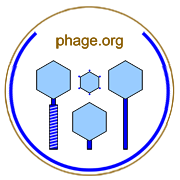

Physiochemical process in which especially the spread of entities is driven by a combination of random motion and in situ generation of new such entities.
Diffusion is the random motion and reaction is the in situ generation of new entities. This is relevant with phages particularly to plaque formation where virion-generating reactions are equivalent to phage infections and diffusion is simply virion random motion. Plaques thus form by a combination of production of new phages, particularly as seen at the periphery of plaques, and subsequent diffusion of virions to new bacteria to infect.
Plaque formation tends to cease particularly when the reaction portion of this process ceases, such as typically occurs when bacterial lawns enter into stationary phase. Plaque size can be limited also to the extent that diffusion is limited such as because of higher agar densities though which virion movement is slower.
Reaction-diffusion predominates as a means of mathematically modeling phage plaque formation. See by contrast stochastic cellular automata, i.e., cellular automata models of plaque formation. For reviews and references, see Krone and Abedon (2008) and Abedon and Culler (2007).
For more on this topic, see Wikipedia, Google, and PubMed. Contact web master. Return to terms.